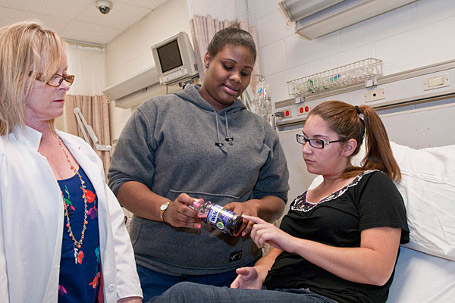Nursing cultural competency : LEARNing to communicate
UD collaboration provides future nurses cultural competency training

Misconstrued lyrics in popular songs can be funny, but miscommunication in a doctor’s office or hospital ER is no joke. Often the result of cultural, religious, and socioeconomic differences, mixed messages can result in incorrect diagnoses and failure to comply with prescribed treatments.
To improve cultural diversity in educating future nurses, a new set of scenarios has been introduced to the University of Delaware’s Healthcare Theatre program through a collaboration with medical anthropologist Melissa Melby.
“In teaching cultural competence, we have to be careful to avoid stereotyping and view the issues in a more dynamic way,” says Melby, who joined UD’s Department of Anthropology as an assistant professor in 2011.
“Our goal with these scenarios is not only to help nursing students understand that there are cultural differences but also to make them aware that the differences may not be as great as people perceive them to be. We want to give these students the tools to work through cultural stereotypes, so that they can deliver effective care to their patients.”
Under Melby’s advisement, students in UD’s Honors Program developed four cultural scenarios based on the common premise that the patient is at an urgent care center for a non-emergency visit.
The scenarios were then implemented in NURS235, Health Vulnerability and Diversity, where the LEARN model is used to navigate this interaction with patients. LEARN is an acronym for “Listen, Explain, Acknowledge, Recommend, Negotiate.”
Karen Avino, co-instructor of NURS235 with Wayne Voelmeck, points out that teaching cultural competence to students when there is no previous frame of reference can be difficult. “Using authentic real-world experiences through simulations makes the didactic material come alive,” she says.
The scenarios, which are not scripts but rather loose frameworks for practitioner-patient interactions, provide the nursing students with a stage for practicing communication skills using the concepts underlying the LEARN model. At the same time the approach gives Melby’s anthropology students the opportunity to observe and assess the nursing students’ interaction with their patients.
“As a professor, I’m really excited to provide my students with this kind of hands-on experience in a medical setting,” Melby says. “Logistically, it would be very difficult to get them into a real doctor’s office or hospital, but UD’s unique structure fosters and facilitates these types of collaborations, which are so valuable in providing our students with experiential learning opportunities.”
One scenario highlights miscommunication stemming from the nurse’s use of the term hypertension and the patient’s reference to high pertension. The former is the biomedical term for high blood pressure, while the latter refers to an incurable African American folk medicine condition in which symptoms are brought on by strong emotions.
In another, a Hispanic patient with poor English language skills is diagnosed with diabetes. In addition to dealing with the language barrier, the nurse has to try to convince the patient that it’s not all right to take her mother’s medication for this disorder.
Amy Cowperthwait, Healthcare Theatre program coordinator, points out that in this scenario, the issue is as much socioeconomic as it is cultural because the patient can’t afford to pay for her own prescription. In the debriefing following the scenario, she praises nursing student Dominique Wisher for helping the patient explore ways to get the correct medication more affordably.
Cowperthwait also gives credit to Mallory Acevedo, who has played the part of the Hispanic patient, for grabbing a bottle of grape juice as a last-minute prop, thereby setting the stage for Wisher to initiate a conversation with her patient about the need to monitor her sugar consumption.
Neil Redfield, who helped to create the Hispanic scenario, admits that culture isn’t something people usually think of in the context of contemporary health care. The project not only raised his awareness of this issue but also gave him the satisfaction of contributing to the education of future practitioners.
Emily Bange, who wrote a scenario featuring a female Muslim patient with a urinary tract infection, says, “This program showed me just how useful anthropology can be in solving the problems we face as citizens of an increasingly globalized world. I really enjoyed the opportunity to give feedback to the nursing students and help them improve their skills and better communicate with patients.”
Cowperthwait, who pioneered the Healthcare Theatre program several years ago with theatre professor Allan Carlsen, admits that at first she was a bit skeptical of the undergraduate anthropology students’ ability to give meaningful feedback to the future nurses.
However, she is glad to have been proven wrong.
“I’m impressed,” she says. “They’ve been spot-on with their comments.”
About the Cultural Diversity Modules
Four Honors students working with medical anthropologist Melissa Melby developed patient scenarios for the Healthcare Theatre program:
- Emily Bange ? Islamic patient scenario;
- Dana Steele ? Jewish patient scenario;
- Neil Redfield ? Hispanic patient scenario; and
- Elizabeth Wilford ? African-American patient scenario.
The nursing students received feedback from students in Melby’s anthropology class as well as from Amy Cowperthwait, Healthcare Theatre program coordinator, and nursing instructor Penny Lewis.
About Healthcare Theatre
Healthcare Theatre, a unique partnership between the College of Health Sciences and the Department of Theatre at the University of Delaware, helps healthcare professionals develop psychosocial skills through interactive scenarios presented by theatre students.
With this transformative approach to education, theatre students are trained to portray patients and family members so that health sciences students can practice both technical and interpersonal skills in a safe environment without compromising quality of care.
